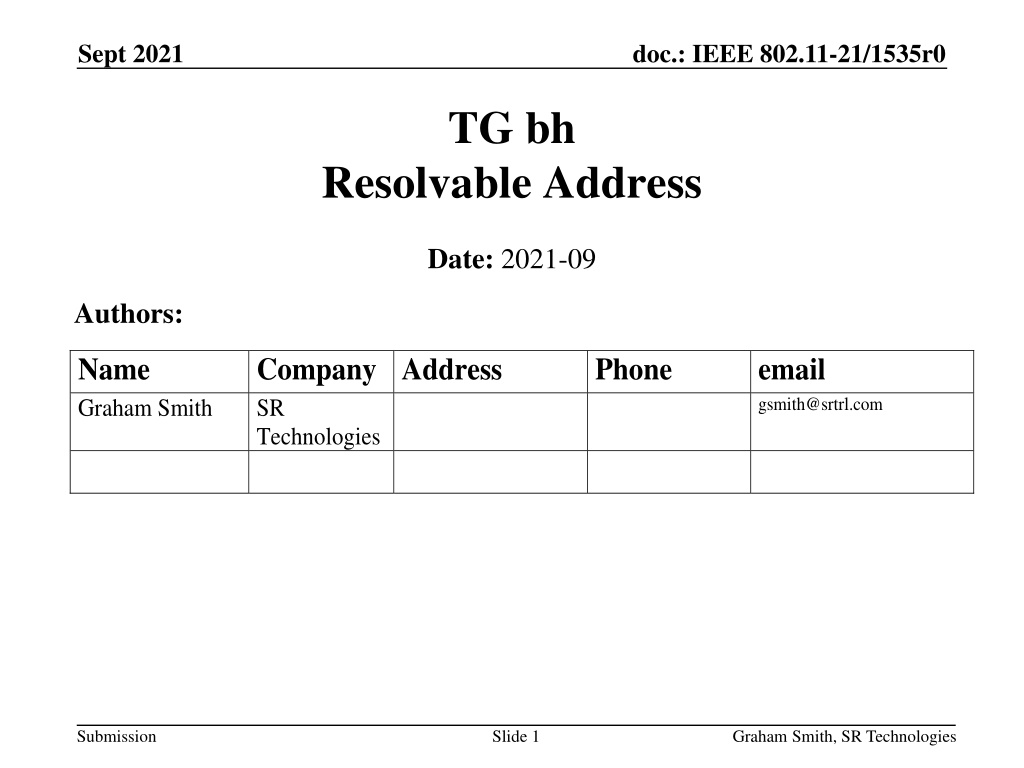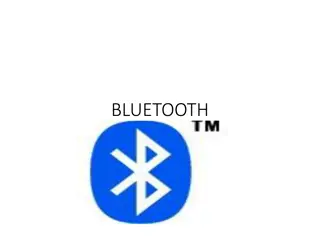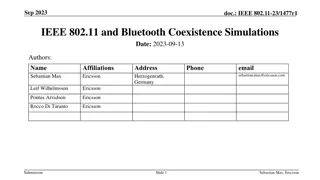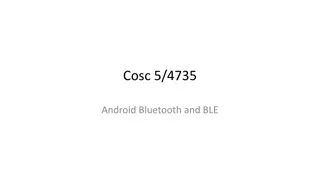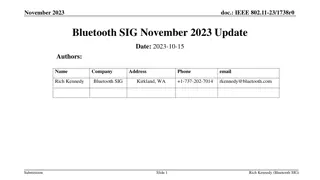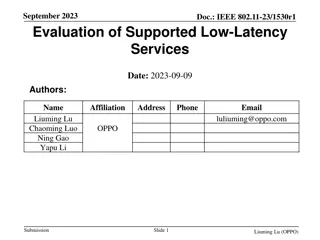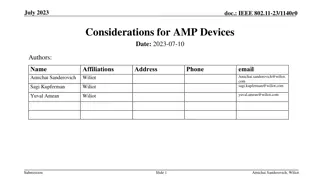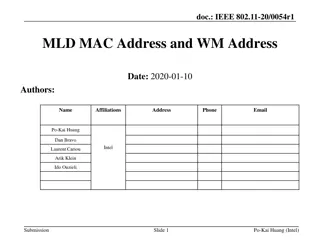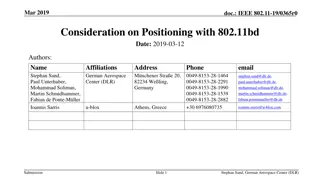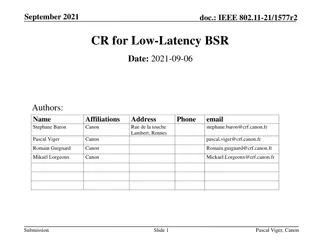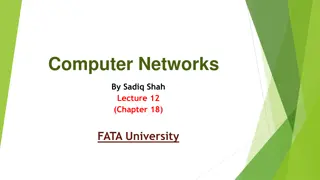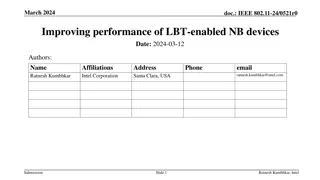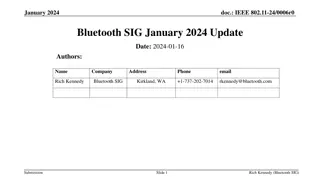Understanding Bluetooth Low Energy Addresses in IEEE 802.11-21/1535r0
The document explores the features of resolvable addresses in Bluetooth Low Energy (BLE) within the IEEE 802.11-21/1535r0 standard. It discusses the two types of addresses in BLE, Public and Random, and their usage. The emphasis is on Random addresses due to their popularity and privacy features. The explanation covers Random Static addresses that can be fixed or changed, and Random Private addresses for privacy protection. Additionally, it delves into Resolvable Private addresses' role in preventing tracking while allowing identification by trusted parties through shared keys like IRK.
Download Presentation

Please find below an Image/Link to download the presentation.
The content on the website is provided AS IS for your information and personal use only. It may not be sold, licensed, or shared on other websites without obtaining consent from the author. Download presentation by click this link. If you encounter any issues during the download, it is possible that the publisher has removed the file from their server.
E N D
Presentation Transcript
Sept 2021 doc.: IEEE 802.11-21/1535r0 TG bh Resolvable Address Date: 2021-09 Authors: Name Graham Smith Company Address SR Technologies Phone email gsmith@srtrl.com Submission Slide 1 Graham Smith, SR Technologies
Sept 2021 doc.: IEEE 802.11-21/1535r0 Resolvable Address Bluetooth Low Energy BLE has a feature of resolvable address. This is an outline of that feature A possible similar use is outlined for 802.11 Disclaimer: I am not expert at this. This is solely from first time reading of BLE Spec. I just think it is worthwhile investigating. Submission Slide 2 Graham Smith, SR Technologies
Sept 2021 doc.: IEEE 802.11-21/1535r0 BLE Addresses MAC Address 48-bit Two Types: Public Random Must use at least one type but can use both Submission Slide 3 Graham Smith, SR Technologies
Sept 2021 doc.: IEEE 802.11-21/1535r0 Random Addresses Random addresses are more popular than Public addresses since they do not require registration with the IEEE. A Random address is an identifier that s either programmed into the device or generated at runtime (depending on the subtype). The two subtypes of Random addresses are: Random Static Address Random Private Address Submission Slide 4 Graham Smith, SR Technologies
Sept 2021 doc.: IEEE 802.11-21/1535r0 Random Static Random Static Addresses can be used in one of two ways: It can be assigned and fixed for the lifetime of the device It can be changed at bootup However, it cannot be changed during runtime. The format of Random Static Addresses looks like this: 1 and 1 are fixed in the most significant bits (MSB) The remaining 46 bits are chosen randomly by the developer/manufacturer Submission Slide 5 Graham Smith, SR Technologies
Sept 2021 doc.: IEEE 802.11-21/1535r0 Random Private Address Resolvable and non-resolvable. Random Private addresses are used specifically for protecting the privacy of a Bluetooth device, to hide the identity, and to prevent tracking of the device. Submission Slide 6 Graham Smith, SR Technologies
Sept 2021 doc.: IEEE 802.11-21/1535r0 Resolvable Private Address Purpose To prevent malicious third-parties from tracking a (Bluetooth) device while still allowing one or more trusted parties from identifying the (Bluetooth) device of interest. Resolvable Uses a key shared with trusted device. Key is referred to as IRK (Identity Resolving Key) Address is originally generated using IRK and a random number In Bluetooth, a trusted device is a bonded device. Bonding is the optional step that takes place after the pairing of two BLE devices. The Bonding process involves the storage of keys by each of the devices that are bonded with each other. Changing address This type of address changes periodically. The recommendation per the Bluetooth specification is to have it change every 15 minutes (this is evident in all iOS devices). Submission Slide 7 Graham Smith, SR Technologies
Sept 2021 doc.: IEEE 802.11-21/1535r0 Resolvable Random Private Address Resolvable Random Private Address format 0 and 1 are fixed in the most significant bits (MSB) The next 22 bits are randomly generated The prand constitutes of these most significant 24 bits The lower 24 bits represent a hash value which is generated using the prand and the IRK Submission Slide 8 Graham Smith, SR Technologies
Sept 2021 doc.: IEEE 802.11-21/1535r0 Steps to implement privacy 1. A key referred to as the IRK (Identity Resolving Key) is used in generating and resolving the resolvable random private address. 2. The IRK generated by each device locally either randomly or assigned during manufacturing. 3. During bonding, each device stores its peer s IRK in what s called a resolving list. 4. The IRK is then used to resolve the private address of a peer device verifying that the hash included in the private address matches the output of the local hash computation according to the following equation: hash = ah(IRK, prand) Since the device has the IRK stored locally and has access to the prand included as part of the private address which is included in the BLE packets, it can perform this computation. It s important to note that the IRK is not used to reveal the peer s Identity Address which is either a Public Address or a Random Static Address, but rather for verification purposes only Submission Slide 9 Graham Smith, SR Technologies
Sept 2021 doc.: IEEE 802.11-21/1535r0 Outline for 802.11 devices Type of Address is identifiable by the two MSBs We use the locally admin bit to indicate random Could we reserve another bit to indicate resolvable or private ? When securely associated, IRKs exchanged and stored by the AP and STA When associating again, the hash included in the address can be verified, and the device identified. Submission Slide 10 Graham Smith, SR Technologies
Sept 2021 doc.: IEEE 802.11-21/1535r0 Advantages Does not require same random address to be used when returning to the same ESS. More secure. Submission Slide 11 Graham Smith, SR Technologies
